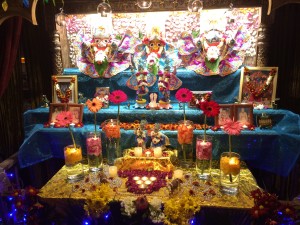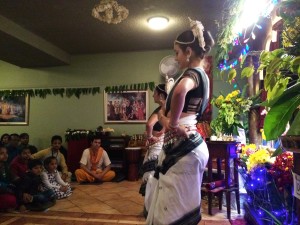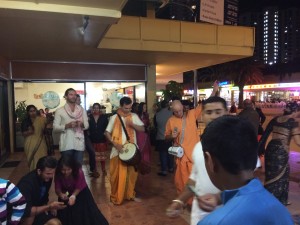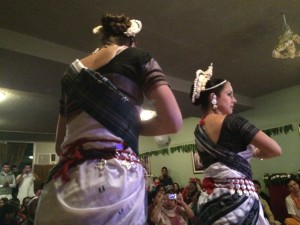A search for God or for the ultimate truth underlying existence has characterized thinking people in various traditions all over the world. Among various conceptions of God that have been revealed, the conception of Krishna is special. One aspect of his specialty is the specialty of his devotees, especially the devotees of Vrindavan, the Vrajavasis.
This claim to specialty is not a matter of subjective sectarian superiority, but objective theological reality. After all, how many other traditions feature devotees praying for God, as do the Vrajavasis, instead of the normative praying to God?
The idea of praying for God sounds startlingly counterintuitive and raises several questions such as “Why would the object of prayer become its subject?” and “Even if someone were to pray for God, whom would they pray to for him?”
Praying for others is itself an act of selflessness, but praying for God is the act of ultimate selflessness.
To grasp the answers, we need to understand a fundamental truth about God in his manifestation as Krishna. In his highest abode, the pastoral paradise of Vrindavana, Krishna delights not in the display of godhood, but in the play of love. To intensify the love between him and his most intimate devotees, he conceals from them his godhood so that they can love him for his personality and not for his position. Due to Krishna’s concealment of his divinity, the Vrajavasis don’t think of him as a person to pray to, but as a person to love. And they love him with every beat of their heart and every breath of their body.
When we love someone, we naturally want the best for our loved ones and do everything we can to arrange for that best. And because we are finite and can’t provide them everything ourselves, we tap the power of prayer to invoke a power far greater than ours: the supreme power of God. We pray to God to protect and bless our loved ones.
Praying for others is itself an act of selflessness, but praying for God is the act of ultimate selflessness. For it features approaching God for God’s sake alone. Such is the supreme selflessness of the Vrajavasis who pray for Krishna’s welfare. The Vrajavasis are not naïve cowherds who don’t know the supreme position of Krishna and so pray for him instead of to him. No, they have the highest philosophical knowledge and the loftiest spiritual realizations, as is evident in their occasional philosophical discourses. But such jnana and vijnana is overshadowed in the sky of their consciousness by their prema. Just as the stars are present in the sky even in daytime but are not visible due to the brightness of the sun, similarly jnana-vijnana is present in their consciousness but is relegated to the background by the intensity of their prema.
Whom do the Vrajavasis pray to?
To Lord Vishnu whom they consider the Supreme Being and to whom Nanda Maharaja, the father of Krishna, is ardently devoted.
Significantly, what the Vrajavasis are unconscious of is Krishna’s divinity, not divinity itself. They are obviously not atheists – they are the topmost theists. They reside conceptually in the worldview revealed in the Vedic texts wherein Vishnu is the Supreme Being. So, when Krishna miraculously dodges dangers and downs demons, the Vrajavasis think of such astonishing happenings as evidences not of his divinity, but of the potency of their devotion, specifically Nanda Maharaja’s devotion, to Vishnu. They believe that Vishnu responding to their prayers has empowered Krishna to do those marvelous deeds. Feeling indebted to Vishnu for answering their prayers, they intensify their devotion to him. But more importantly, feeling overwhelmingly relieved and delighted that their beloved has returned unscathed from the jaws of death, their love for him increases manifold, thus relegating even devotion to Vishnu to the background so as to undistractedly relish the sweetness of Krishna’s proximity.
Rupa Goswami, a sixteenth century bhakti theologian, explains that even among the various revelations of God within the Vedic tradition, Krishna holds a special place due to four distinctive qualities: rupa-madhuri (enchantingly sweet form), lila-madhuri (entrancingly sweet pastimes), venu-madhuri (enthrallingly sweet flute-play) and bhakta-madhuri (endearingly sweet devotees). Bhakta-madhuri is exemplified in the Vrajavasis who play with him and pray for him? Where else in the world, nay in the universe, nay in the entire material existence, nay in all of existence – material and spiritual, can we find love so selfless, so intimate, so sweet?
A heartfelt appreciation for Nanda Maharaja’s exalted devotion underlies this extraordinary eulogy to him.
shrutim apare smritim itare
bhaaratam anye bhajantu bhava-bhitaah
aham iha nandam vande
yasyalinde param brahma
"Let others, fearing material existence, worship the Vedas, the Vedic supplementary Puranas and the Mahabharata, but I shall worship Nanda Mahäräja, in whose courtyard the Supreme Brahman is crawling."
- Raghupati Upadhyaya, Padyavali 126
(Nandotsava: Nanda-utsava, festival of Nanda Maharaj; the day after Janmashtami when Nanda Maharaja celebrated Krishna’s birth.)
 Sri Krishna Janmashtami is the appearance anniversary of Krishna, the Supreme Person. He's not "born" like we are—He comes and goes as He likes—but He appears here to please His devotees, rid the earth of evildoers, and give the rest of us something worthwhile to talk about. Read more ›
Sri Krishna Janmashtami is the appearance anniversary of Krishna, the Supreme Person. He's not "born" like we are—He comes and goes as He likes—but He appears here to please His devotees, rid the earth of evildoers, and give the rest of us something worthwhile to talk about. Read more ›  Sri Krishna Janmashtami is the appearance anniversary of Krishna, the Supreme Person. He's not "born" like we are—He comes and goes as He likes—but He appears here to please His devotees, rid the earth of evildoers, and give the rest of us something worthwhile to talk about. Read more ›
Sri Krishna Janmashtami is the appearance anniversary of Krishna, the Supreme Person. He's not "born" like we are—He comes and goes as He likes—but He appears here to please His devotees, rid the earth of evildoers, and give the rest of us something worthwhile to talk about. Read more ›  Janmashtami commemorates the earthly appearance of Krishna, who is described in India’s sacred writings as God Himself. One of the biggest religious festivals in the world, it is celebrated by nine hundred and thirty million people around the world–and two million in the US alone. To devotees, it’s Christmas and New Year’s in one, a day of deep spiritual renewal and celebration that effectively finishes an old year and begins a fresh one.
Janmashtami commemorates the earthly appearance of Krishna, who is described in India’s sacred writings as God Himself. One of the biggest religious festivals in the world, it is celebrated by nine hundred and thirty million people around the world–and two million in the US alone. To devotees, it’s Christmas and New Year’s in one, a day of deep spiritual renewal and celebration that effectively finishes an old year and begins a fresh one. 
 Janmashtami, the birthday of Lord Krishna is celebrated with great devotion and enthusiasm in India in the month of July or August.
Janmashtami, the birthday of Lord Krishna is celebrated with great devotion and enthusiasm in India in the month of July or August.  We have great news about printing Srila Prabhupada’s books. For the first time, the BBT's Far East/Middle East division has printed Arabic books. Srila Prabhupada once said, “Anyone who preaches in any way in the Muslim world, I take the dust of their feet on my head!” Preaching in Muslim countries can be risky, and that is why Prabhupada said this. But now we find Muslims all over the world, and the book distributors are discovering that they are actually enthusiastically reaching out for the books. Many of them read only Arabic, or even if they read another language, nothing beats their native language, which they always ask for.
We have great news about printing Srila Prabhupada’s books. For the first time, the BBT's Far East/Middle East division has printed Arabic books. Srila Prabhupada once said, “Anyone who preaches in any way in the Muslim world, I take the dust of their feet on my head!” Preaching in Muslim countries can be risky, and that is why Prabhupada said this. But now we find Muslims all over the world, and the book distributors are discovering that they are actually enthusiastically reaching out for the books. Many of them read only Arabic, or even if they read another language, nothing beats their native language, which they always ask for. 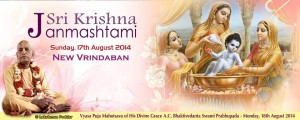
 The ISCOWP staff went to the auction barn to save 3 calves. They came home with 8 calves. The conditions of the auction barn and the cows overwhelmed them and they had to save more. Please help us take care of them!
The ISCOWP staff went to the auction barn to save 3 calves. They came home with 8 calves. The conditions of the auction barn and the cows overwhelmed them and they had to save more. Please help us take care of them!  Wonderful Darshan!
Wonderful Darshan!  Hundreds of millions of adherents of the Hindu faith will gather together, around the world, in temples and homes, to celebrate the advent of God on Earth. This festival of the birth of Krishna is known in Hinduism as Janmastami. According to the popular understanding, Krishna took birth in the town of Mathura, located in Northern India, 91 miles South of New Delhi, approximately 5,000 years ago. This year, the celebration will take place on Sunday, August 17.
Hundreds of millions of adherents of the Hindu faith will gather together, around the world, in temples and homes, to celebrate the advent of God on Earth. This festival of the birth of Krishna is known in Hinduism as Janmastami. According to the popular understanding, Krishna took birth in the town of Mathura, located in Northern India, 91 miles South of New Delhi, approximately 5,000 years ago. This year, the celebration will take place on Sunday, August 17.  Chanting gradually diminishes the propensity to sin and simultaneously purifies the consciousness. As the inclination to commit sinful activities vanishes, taste for the holy name appears, though a faint residue of previous sinful activity still lingers on in the consciousness. The receeding sinful reactions leave an odor of sinful habit (papa gandha), but the chanter's contact with the name engenders a strength of willpower and a purity of mind that overcomes this clinging smell of sin.
Chanting gradually diminishes the propensity to sin and simultaneously purifies the consciousness. As the inclination to commit sinful activities vanishes, taste for the holy name appears, though a faint residue of previous sinful activity still lingers on in the consciousness. The receeding sinful reactions leave an odor of sinful habit (papa gandha), but the chanter's contact with the name engenders a strength of willpower and a purity of mind that overcomes this clinging smell of sin.  The arrival of massive packages of roses and other beautiful flowers at Sri Jagannatha Mandir KL (SJMKL) past 2 days , made the hearts of devotees leap in joy as the long awaited celebration, Janmastami is truly very close now. With only one day before the auspicious day, devotees and huge number of volunteers gathered at the temple to participate in various activities in preparation to welcome the grand event. Gorgeous garlands were made out of the fresh and fragrant flowers which would adorn the merciful lordships, huge and colorful Rangolis were painted on the temple floors to add excitement to the glorious celebrative atmosphere and pots were drawn with beautiful designs and were painted colorfully.
The arrival of massive packages of roses and other beautiful flowers at Sri Jagannatha Mandir KL (SJMKL) past 2 days , made the hearts of devotees leap in joy as the long awaited celebration, Janmastami is truly very close now. With only one day before the auspicious day, devotees and huge number of volunteers gathered at the temple to participate in various activities in preparation to welcome the grand event. Gorgeous garlands were made out of the fresh and fragrant flowers which would adorn the merciful lordships, huge and colorful Rangolis were painted on the temple floors to add excitement to the glorious celebrative atmosphere and pots were drawn with beautiful designs and were painted colorfully.  Indradyumna Swami: We are on the home stretch of our summer festival tour here in Poland with just 10 days left to go. One can only marvel at the sincerity of these devotees who have kept up such an intense pace for almost two months now. In appreciation for their services Lord Caitanya is giving them a genuine taste of the nectar for which we all hanker. Sri Krsna Samkirtan ki jaya!
Indradyumna Swami: We are on the home stretch of our summer festival tour here in Poland with just 10 days left to go. One can only marvel at the sincerity of these devotees who have kept up such an intense pace for almost two months now. In appreciation for their services Lord Caitanya is giving them a genuine taste of the nectar for which we all hanker. Sri Krsna Samkirtan ki jaya! 



